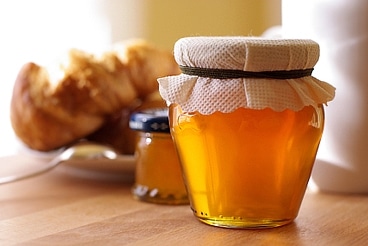Taste: The Gift Of The Bees
The huge "Beware of Bees" sign makes no sense on Pali Lookout. The wind howls up here at what is maybe the best view on Oahu, an island where nearly every view is flawless: all knife-edge mountains wrapped in green. But bees can't fly in heavy wind. Even with protection from La'amaomao, goddess of wind, peace and prosperity, their little wings would rip right off. But apparently some bees have braved the heights. Like a musician's gift of song, bees offer the gift of landscape, the most elemental flavor the world holds: honey.
Honey is the distillation of every plant, sunbeam and shadow under the canopy of tall trees. Honey is the beauty of flowers, offered up to another sense. A bee might fly upwards of 50 miles a day to gather nectar, yet over the course of her life that may amount to just 1/12 of a teaspoon of honey — or a single drop. Or look at it this way: To make a pound of honey, the 50,000 or so bees from the average hive may have flown enough miles to add up to a trip to the moon.
My own honey journey began when I was a kid, when my beekeeping father pulled the honey out of our hives. That scent — the entire world in a jar — filled my senses and left me with a hunger for a taste of color made tangible.
Here in Hawaii, the most popular kind of honey is kiawe. Apis mellifera, the domestic honeybee, of course never flew to Hawaii; it was first brought on ships in the 1800s by people who knew that the flavors of these jungled islands would be amazing. And they were right. Kiawe, a pretty, tasty white honey, is just one of Hawaii's honey varieties. Still, in each grocery store I visit, whether in Honolulu or on the outskirts of Waialua, that's about all that's on offer: either kiawe or imported honey in plastic bears. Because make no mistake: All honeys are not the same. That bear honey is a mutt, a blend from Chinese or Brazilian hives, with no attention paid to what kind of flowers the bees are chasing. Truly fine honey is flower-specific, and Hawaii's convoluted geography means that a lot of these flavors can be crammed into a very small space.
Just ask the Hawaiian Honey Bee Coop As co-op member Rhea McWilliams says, Oahu's drastic elevations mean the island "is in a unique situation to produce many kinds of honey."
To taste it for myself, I visit the coop's table at the Kapi'olani Community College Farmer's Market one Saturday. They offer me honey tastes ranging from cotton-candy sweet to rich and dark as pure molasses.
Rhea explains, "We'll have 15 kinds of honey, so it's like wine tasting. There are remarkable differences, and people walk away with a completely different sense of honey. Once they see the range of flowers and colors, they become believers. We actually have people who curse us because they can't buy the $2.99 stuff anymore."
I suck on the tasting spoon until I'm tasting nothing but plastic, then hold it back out while Rhea grabs the next jar for me to try. This, I realize, is the best way to taste honey: standing outside in the landscape where the flavors come from. I'm smelling the landscape, tasting the flavor, watching a rain cloud come in that will close some flowers and open others, shifting the taste of the next harvest like a grace note in a symphony.
Later, John Dalire — a co-op member who's spent eight years learning how to build hives, extract honey and make sure the bees stay healthy — hands me a jar from his kahalu'u hives, honey that carries the sweetness of lychee and starfruit, its two dominant nectar sources. I open it with all the honor the gift deserves, and think of my father driving up to our suburban house one night with his first beehive in the back of his truck. That was almost 40 years ago, and it turns out, that moment was directly responsible for this moment. Because I grew up learning the landscape of home through its taste, I know what I need to do for the rest of my trip.
I begin to take jars of honey back to where they began, dip a finger into the rich liquid and let the tastes teach me what I'm seeing. In the landscape where it belongs, kiawe's mild flavor gains a tang. With the scent of the lagoons where the trees like to stretch their thorns, macadamia nut honey is nicely sweet, with just a hint of bitterness in the aftertaste. And the old-comb Olomana honey is one of the best things I've ever tasted, as bathed in sunshine as the pali. I might not eat for the rest of the day. I want this flavor to linger as long as possible.
Edward Readicker-Henderson, shares more about his love of honey in his upcoming book, A Short History of the Honey Bee.
